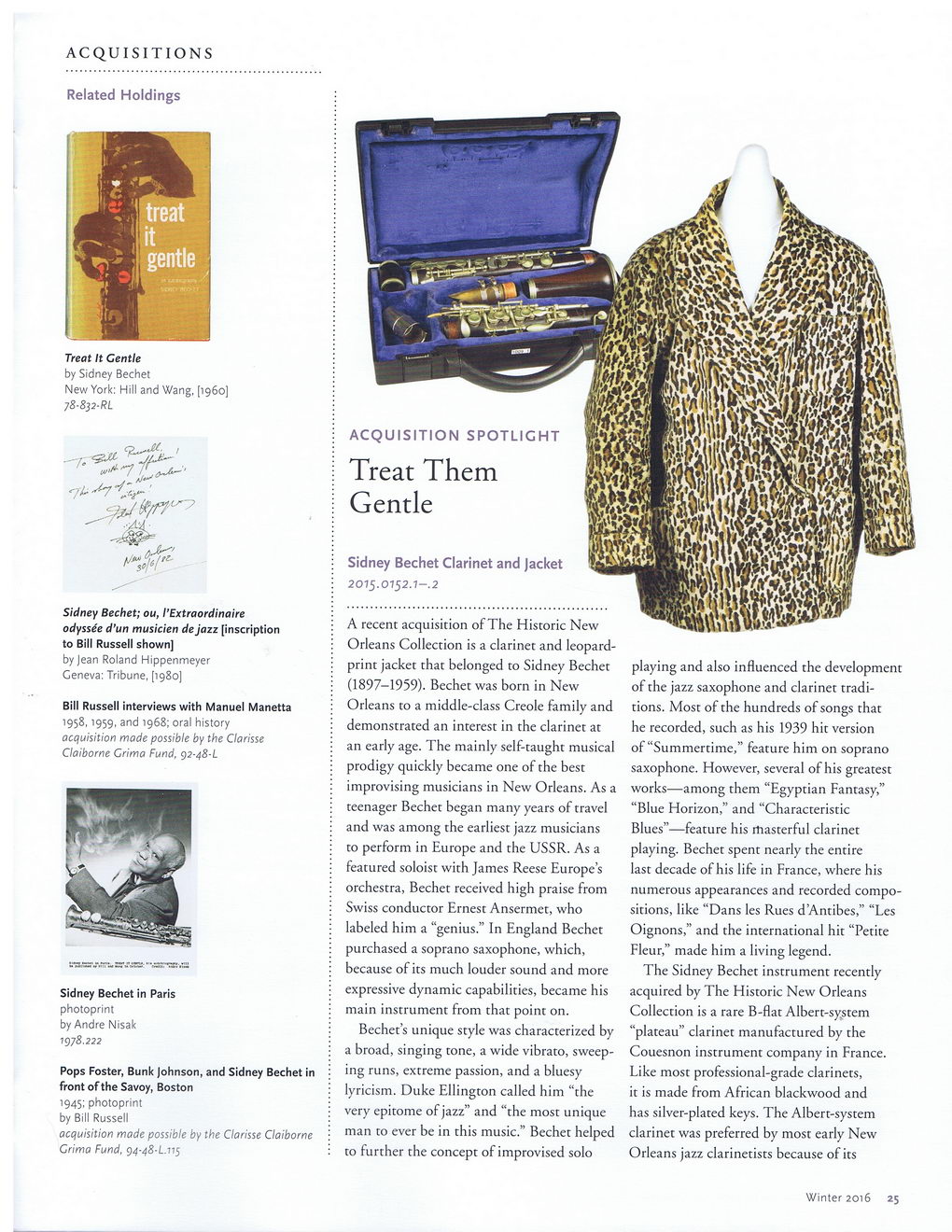This text was obtained via automated optical character recognition.
It has not been edited and may therefore contain several errors.
ACQUISITIONS Related Holdings Treat It Gentle by Sidney Bechet New York: Hill and Wang, [i960] 78-832-RL T. "JM-' L u-7 Sidney Bechet; ou, I’Extraordinaire odyssee d’un musicien de jazz [inscription to Bill Russell shown] by Jean Roland Hippenmeyer Geneva: Tribune, [1980] Bill Russell interviews with Manuel Manetta ’958,1959, and 1968; oral history acquisition made possible by the Clarisse Claiborne Crima Fund, 92-48-1 Sidney Bechet in Paris photoprint by Andre Nisak 7978.222 Pops Foster, Bunk Johnson, and Sidney Bechet in front of the Savoy, Boston 1945; photoprint by Bill Russell acquisition made possible by the Clarisse Claiborne Grima Fund, 94-48-L.115 ACQUISITION SPOTLIGHT Treat Them Gentle Sidney Bechet Clarinet and Jacket 2075.0152.7-2 A recent acquisition of The Historic New Orleans Collection is a clarinet and leopard-print jacket that belonged to Sidney Bechet (1897-1959). Bechet was bom in New Orleans to a middle-class Creole family and demonstrated an interest in the clarinet at an early age. The mainly self-taught musical prodigy quickly became one of the best improvising musicians in New Orleans. As a teenager Bechet began many years of travel and was among the earliest jazz musicians to perform in Europe and the USSR. As a featured soloist with James Reese Europe’s orchestra, Bechet received high praise from Swiss conductor Ernest Ansermet, who labeled him a “genius.” In England Bechet purchased a soprano saxophone, which, because of its much louder sound and more expressive dynamic capabilities, became his main instrument from that point on. Bechet’s unique style was characterized by a broad, singing tone, a wide vibrato, sweeping runs, extreme passion, and a bluesy lyricism. Duke Ellington called him “the very epitome of jazz” and “the most unique man to ever be in this music.” Bechet helped to further the concept of improvised solo playing and also influenced the development of the jazz saxophone and clarinet traditions. Most of the hundreds of songs that he recorded, such as his 1939 hit version of “Summertime,” feature him on soprano saxophone. However, several of his greatest works—among them “Egyptian Fantasy,” “Blue Horizon,” and “Characteristic Blues”—feature his masterful clarinet playing. Bechet spent nearly the entire last decade of his life in France, where his numerous appearances and recorded compositions, like “Dans les Rues d’Antibes,” “Les Oignons,” and the international hit “Petite Fleur,” made him a living legend. The Sidney Bechet instrument recently acquired by The Historic New Orleans Collection is a rare B-flat Albert-system “plateau” clarinet manufactured by the Couesnon instrument company in France. Like most professional-grade clarinets, it is made from African blackwood and has silver-plated keys. The Albert-system clarinet was preferred by most early New Orleans jazz clarinetists because of its Winter 2016 25

New Orleans Quarterly 2016 Winter (27)